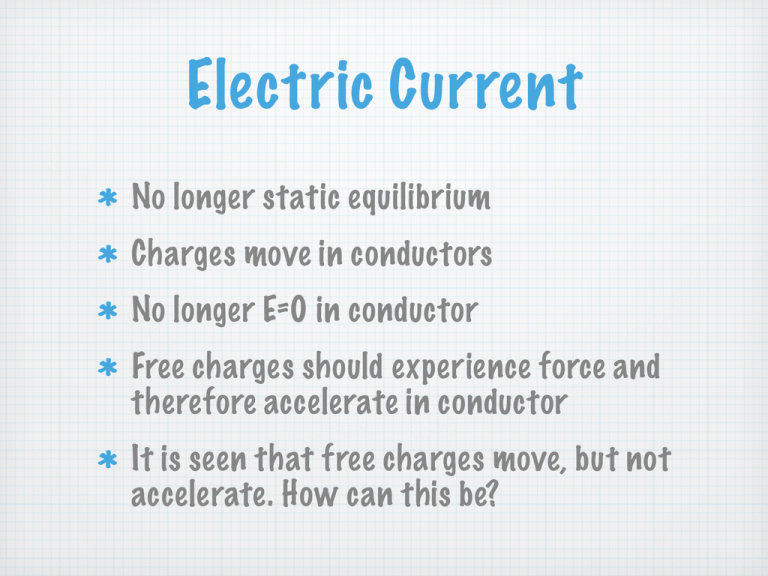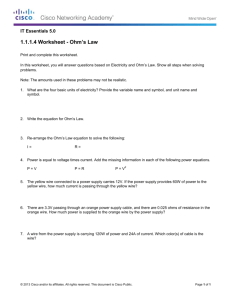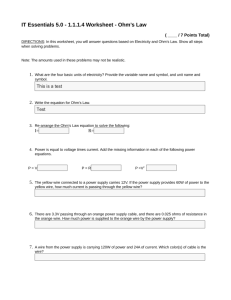Electric Current
advertisement

Electric Current No longer static equilibrium Charges move in conductors No longer E=0 in conductor Free charges should experience force and therefore accelerate in conductor It is seen that free charges move, but not accelerate. How can this be? Conduction in metals – E + + + + + + + + + + + + + + + + + + The path of an electron through a metal. Path is almost completely random, but in presence of an electric field there is a drift τ = “collision time” = mean (typical) time bet ween collisions 1 ! 1 ! !a = F = (−eE) m m ! eE !vd = !aτ = − τ m acceleration (bet ween collisions) “drift velocity” is velocity of average motion of electrons Current density, J: Count how many charge carriers cross a surface per unit area (of the surface) per unit time. We really want how much charge, rather than how many carriers. So multiply by charge of carrier. q · (number of carriers crossing dA in time dt) ! J≡ dA · dt direction of vector is direction of motion of charge carriers Well now: Recall? + A V E A ρ J E E (a) (a) + A V A 90° E 90° ρ J E E (b) (b) + V A and we see that the charge crossing the A surface per unit time is ! dI = J!–· dA We will return to A this, but let’s mention this is the “electric current” – A θ θ ρ E J E (c) – E (c) I= ! ! J!A· dA vd n Charges/unit volume + + + + + + + + + + + (COB) J! = nq!vd A + Ohm’s Law Put together t wo previous results, for metals (q=-e): J! = nq!vd & ! eE !vd = − τ m 2 ne τ ! J! = E m ⇒ Current density is proportional to applied field Not a “law” but an empirical relation for how conductors behave in some conditions Counterpart for current later ! J! = σ E ⇒ σ = “conductivity” ρ = “resistivity” ne2 τ σ= m 1 ρ= σ ! = ρJ! E Material Resistivity (V.m/A) Copper 1.68 x 10-8 Blood, human 0.70 Ceramics, glass, rubber 1010 — 1017 other conduction mechanisms (see text for some of these, but won’t cover here) semiconductors ionic solutions plasmas superconductors Example: Copper at room temperature contains 1.1 x 1029 free electrons per cubic meter. What is the collision time for these electrons? Ans: 1.9 x 10-14 s need m=9.11 x 10-31 kg, e=1.6 x 10-19 C and conductivity for table, and m ρ= 2 ne τ I= ! Current ! = charge crossing surface S per unit time J! · dA S dq = Unit: dt Ampere = Coulomb/sec Surface S usually cross section of wire: + + + + + + – – – – – – (a) I we need to supply a direction for I: the direction of I is the direction of motion of positive charge carriers Analogy: water flow in a pipe charge conser vation These four wires are made of the same metal. Rank in order, from largest to smallest, the electron currents ia to id. 1. 2. 3. 4. 5. id > ia > ib > ic ib = id > ia = ic ic > ia = ib > id ib = ic > ia = id ic > ib > ia > id These four wires are made of the same metal. Rank in order, from largest to smallest, the electron currents ia to id. 1. 2. 3. 4. 5. id > ia > ib > ic ib = id > ia = ic ic > ia = ib > id ib = ic > ia = id ic > ib > ia > id Rank in order, from largest to smallest, the current densities Ja to Jd in these four wires. 1. 2. 3. 4. 5. Jb = Jd > Ja > Jc Jb > Ja > Jc > Jd Jb > Ja = Jd > Jc Jc > Jb > Ja > Jd Jc > Jb > Ja = Jd Rank in order, from largest to smallest, the current densities Ja to Jd in these four wires. 1. 2. 3. 4. 5. Jb = Jd > Ja > Jc Jb > Ja > Jc > Jd Jb > Ja = Jd > Jc Jc > Jb > Ja > Jd Jc > Jb > Ja = Jd Ohm’s Law, again + V – E ρ A J recall: V I= R 1! ! J= E ρ (COB) ρ" R= A units of R: ohm (Ω) = Volt/Ampere Resistance Example: What should be the diameter of an aluminum wire that carrier 15 A when the voltage across 1.0 m of the wire is 0.25 V? Ans: 1.4 mm (need resistivity of aluminum: 2.65 x 10-8 Ω.m) Ohm’s Law You double the voltage across 1) Ohm’s law is obeyed since the current still increases when V a certain conductor and you increases observe the current increases 2) Ohm’s law is not obeyed three times. What can you conclude? 3) This has nothing to do with Ohm’s law Ohm’s Law You double the voltage across 1) Ohm’s law is obeyed since the current still increases when V a certain conductor and you increases observe the current increases 2) Ohm’s law is not obeyed three times. What can you conclude? 3) This has nothing to do with Ohm’s law Ohm’s law, V = I R, states that the relationship between voltage and current is linear. Thus for a conductor that obeys Ohm’s Law, the current must double when you double the voltage. Follow-up: Where could this situation occur? Wires I Two wires, A and B, are made of the 1) dA = 4 dB same metal and have equal length, but the resistance of wire A is four 2) dA = 2 dB times the resistance of wire B. How do their diameters compare? 3) dA = dB 4) dA = 1/2 dB 5) dA = 1/4 dB Wires I Two wires, A and B, are made of the 1) dA = 4 dB same metal and have equal length, but the resistance of wire A is four 2) dA = 2 dB times the resistance of wire B. How do their diameters compare? 3) dA = dB 4) dA = 1/2 dB 5) dA = 1/4 dB The resistance of wire A is greater because its area is less than wire B. Since area is related to radius (or diameter) squared, the diameter of A must be two times less than B. Wires II A wire of resistance R is 1) it decreases by a factor 4 stretched uniformly (keeping its volume constant) until it is twice 2) it decreases by a factor 2 3) it stays the same its original length. What happens to the resistance? 4) it increases by a factor 2 5) it increases by a factor 4 Wires II A wire of resistance R is 1) it decreases by a factor 4 stretched uniformly (keeping its volume constant) until it is twice 2) it decreases by a factor 2 3) it stays the same its original length. What happens to the resistance? 4) it increases by a factor 2 5) it increases by a factor 4 Keeping the volume (= area x length) constant means that if the length is doubled, the area is halved. Since , this increases the resistance by four. Resistors: devices that are pieces of conductors made to have specific resistance Notation for circuit diagrams: we’ll mostly use A and sometimes D Electric Power Electrons loose energy in collisions with atoms in lattice This energy goes into lattice vibrations, raising the temperature of the material To maintain current energy has to be provided externally at a fixed rate P=dE/dt This energy is usually from a battery or some other such source Power: general device V P =IV I derivation: dW = dq V ⇒ dW dq P = = V dt dt Power dissipated by resistor 2 V P = IV = I 2 R = R Example: A power line has 0.20 ohms resistance per kilometer of length. It carries 300 A of current. Find: (a) the voltage across 1.0 km of the wire, and (b) the power dissipated in each kilometer of the wire Ans: (a) 60 V, (b) 18 kW






